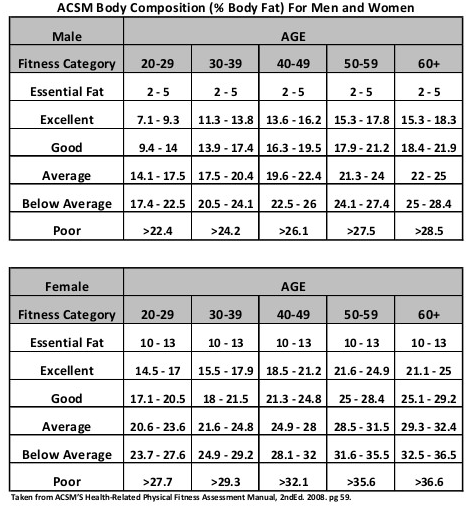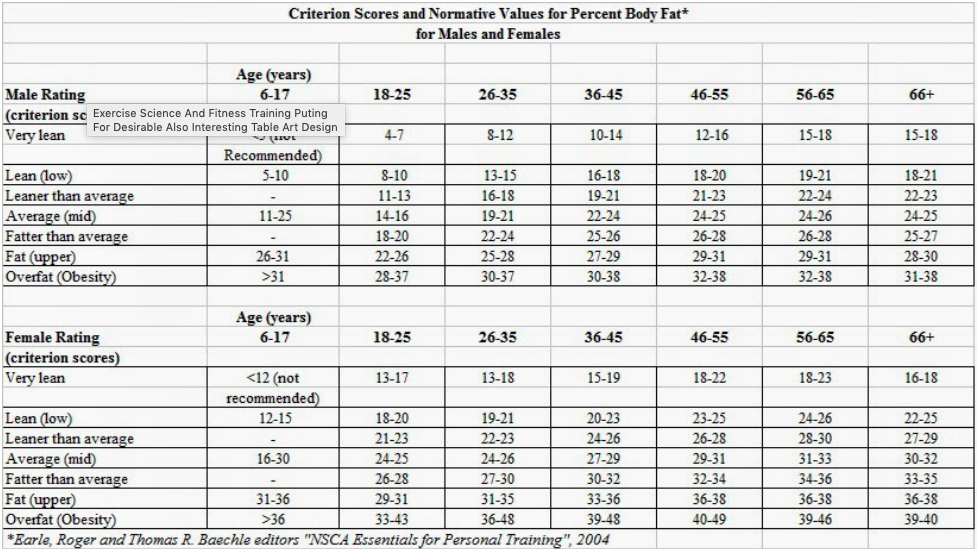Weight Loss: First Steps
Most of us in pursuit of improving our health and/or fitness today are focused on “losing” weight. But what do we mean when we say that we want to lose weight? Do we mean that we do not care what we lose as long as we lose “weight”? Hopefully the answer to this question is no.
We should emphasize reducing (losing) body fat to a healthy range. What are ranges for some comparison? The charts below illustrate body fat ranges for men and women at various age categories.
Identify Current Body Fat
Not sure of your body fat. Find an expert for the most accurate assessment of your current body fat. It is generally a good practice to find an expert that does both body fat calipers and some form of either bioelectric impedance or dexa scanning. Hydrostatic weighing would be great and is the most accurate but it’s expensive and not easily accessible for most of us. Bioelectric impedance is an efficient and cost effective way to monitor your body fat and progress. You can buy devices for home monitoring. These devices are not as accurate as the more expensive assessments offered such as those with hydrostatic weighing or dexa scan but you can always get the more expensive assessments to confirm the progress you are seeing with at home monitoring. Below you’ll find charts by the two most respected health and fitness organizations in the world the ACSM (American College of Sports Medicine) and the NSCA (National Strength and Conditioning Association). Align your expectations with the effort and sacrifices you’re willing to make so that you’re not discouraged by what you’re seeing from your measurements.


Understanding Risks and Programming for Success
With an accurate measurement of your body fat, understanding which category you are in and the risks or benefits are associated with your current body fat it is time to formulate a plan. Based upon your risks and goals you’ll design a plan for lifestyle change or program the next phase of training to continue seeing results. The body acclimates quickly to stimulus, if the stimulus remains constant then the body slowly stops making progress and slips into maintenance soon after which it slides further backward and begins to regress. Why does this happen? Because the body is a highly efficient machine that can learn to adapt quickly. By learning quickly we mean that your body will understand and develop a pathway that it will memorize in order to perform the task with less and less effort thus adaptation slows and then haults. You must progressively challenge your body to adapt. The stimulus you challenge your body with can come in many forms.
Types of stimulus to promote change:
- Repetitions (number of reps performed)
- Sets (number of sets performed)
- Tempo (speed of repetition)
- Rest and Work ratios (rest between exercises and/or sets or circuits)
- Volume (how much work you’re performing and can far more specific as in the how much work with a given muscle group)
- Intensity (how hard you’re training)
- Duration (how long you’re training)
Initial steps to body transformation
Identify the reasons for which you are in need of or desire a change in your composition this helps to prioritize it is importance and decide on support needed. Identify all of the influences that got you to where you are today. Identify the habits you’re ready to change immediately. Identify the habits you’ll be ready to change in the future. Identify habits you’re not willing to change and the possible obstacles they create. Identify your expectations. How long until you realize the transformation? What milestones should you hit on your way to reaching the transformation? Answering these questions helps to align expectations. Most people we work with struggle to have success because their expectations do not align well with what they are willing to change, put in or prioritize.
Here are some contributors to success and/ or factors limiting progress (click the links to learn more about their role):
References:
